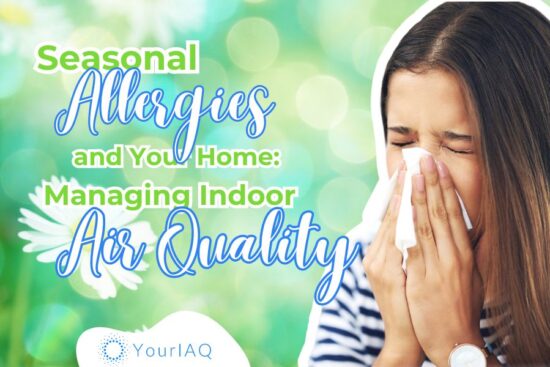
You might not realize it, but the air inside your home can be full of pollutants. These pollutants can come from a variety of sources, including cleaning products, pets, scented candles, and even your furniture.
Fortunately, there are some simple steps you can take to improve the indoor air quality in your home. In this article, we’ll share how to test for contaminants and what actions you can take to make your home’s air healthier to breathe. If you’re concerned about the quality of the air in your home, read on!
How to test your home’s indoor air quality
Testing the air quality in your home is an important step in ensuring that you and your family are breathing clean, healthy air. There are a variety of methods available to test indoor air quality, ranging from simple DIY tests to professional testing services.
DIY Testing Kit
Your choice of testing method depends on the specific pollutants of concern, the level of accuracy required, and your available budget. One such method is using a home testing kit. These are affordable and relatively easy-to-use kits that can detect certain pollutants such as radon, mold, and formaldehyde. The kits come with instructions and typically involve collecting a sample of air or surface and sending it to a laboratory for analysis. You should be aware, however, that a testing kit will only give you a readout of the air at the time you collect the sample. But pollutant levels can fluctuate rapidly.
Professional Air Quality Testing
If DIY isn’t your style, another option is to hire a professional to conduct a comprehensive air quality test. They will use specialized equipment to test for a range of pollutants such as VOCs, carbon monoxide, and particulate matter. This method will likely be expensive, but it provides an accurate and comprehensive analysis of indoor air quality.
Continuous Monitoring
While these are certainly viable options, they only provide a snapshot of your home’s air, not an ongoing analysis of the air you’re breathing. That’s where continuous air monitoring devices come in. This involves using a device to monitor air quality in real-time. Devices can measure pollutants such as CO2, temperature, humidity, and particulate matter. Ours, for example, measures for over 25 indoor air components. Continuous monitoring provides a real-time view of indoor air quality and allows for quick identification of any changes in air quality.
Overall, there are several methods to test indoor air quality. It’s important to choose the appropriate testing method for your needs, so you can identify pollutants of concern and take necessary steps to improve indoor air quality.
5 ways to improve your home’s indoor air quality
Once you know what contaminants are affecting your home’s air, you can take steps to mitigate them and improve your indoor air quality and your health. The EPA recommends s basic strategy for improving indoor air quality that involves controlling the source, ventilating, and cleaning the air. While not an exhaustive list, the following 5 tips can help you get started in improving your home’s air quality.
1. Ventilate
As a general rule, increasing ventilation will drastically improve air quality. According to one WHO report, pollutants are 1,000 times more likely to be inhaled indoors than outdoors. Allowing proper air flow decreases these risks. Find ways to circulate fresh air from outside. Open doors and windows, use attic fans or exhaust fans in the kitchen and bathroom, and install a mechanical ventilation system if necessary. Pollutants that start in the home don’t have to stay there.
2. Clean regularly
Regular cleaning can help reduce the buildup of dust, pet dander, and other indoor air pollutants. Use a vacuum cleaner with a HEPA filter to clean carpets and furniture, and wipe down surfaces with a damp cloth to remove dust. Remember to ventilate, as cleaning products and disinfectants can also emit unhealthy VOCs that remain in the house.
3. Regulate humidity
High humidity promotes the growth of mold and mildew, which can cause respiratory problems. Use a dehumidifier in damp areas such as the basement or bathroom and fix any leaks or water damage promptly. These issues can be difficult (and expensive) to fix once they begin, so it’s good to invest in this equipment before it becomes a problem.
4. Invest in an air purifier
Air purifiers may help remove indoor air pollutants such as pet dander, pollen, and mold spores. Choose a purifier with a HEPA filter and regularly replace the filter as recommended by the manufacturer. In fact, some purifiers can even kill microbes, keeping you and your loved ones healthy throughout flu season.
5. Use natural cleaning products
Many conventional cleaning products contain harmful chemicals that can contribute to poor indoor air quality. Use natural cleaning products or make your own using non-toxic ingredients such as vinegar and baking soda.
The importance of indoor air quality
Poor indoor air quality can have serious health implications, both in the short and long term. Airborne contaminants often cause a number of acute issues and, over time, can lead to chronic illness and cancer. Others can be fatal in the short term if inhaled in high concentrations. Knowing how poor air quality is affecting your health is the first step to fixing it.
Poor indoor air quality can cause or worsen respiratory problems such as asthma, allergies, and chronic obstructive pulmonary disease (COPD). Exposure to indoor pollutants like mold, dust mites, pet dander, and cigarette smoke can irritate the lungs and trigger asthma symptoms, even for those who have not previously experienced these conditions.
Beyond this, exposure to high levels of carbon monoxide and volatile organic compounds (VOCs) can cause headaches and dizziness. In high concentrations, carbon dioxide also causes fatigue and reduced focus, compromising cognitive ability and impacting daily activities and productivity.
Heart disease and cancer are the two leading causes of death in the United States, and long-term exposure to certain indoor air pollutants increases one’s risk of both. Such pollutants include radon, asbestos, and formaldehyde, which are common but which few homes regularly test for.
Why we started IAQ
We believe improving air quality and limiting health risks starts at home, and we want it to be easy for everyone. That’s why we’ve developed IAQ—it empowers you by putting air quality data in your hands and making recommendations on how you can improve your air.
This small, no-setup device helps prevent unknown exposure to harmful pollutants and gives you more control over your home environment. Because no one should have to worry about the consequences that come from breathing polluted air.






